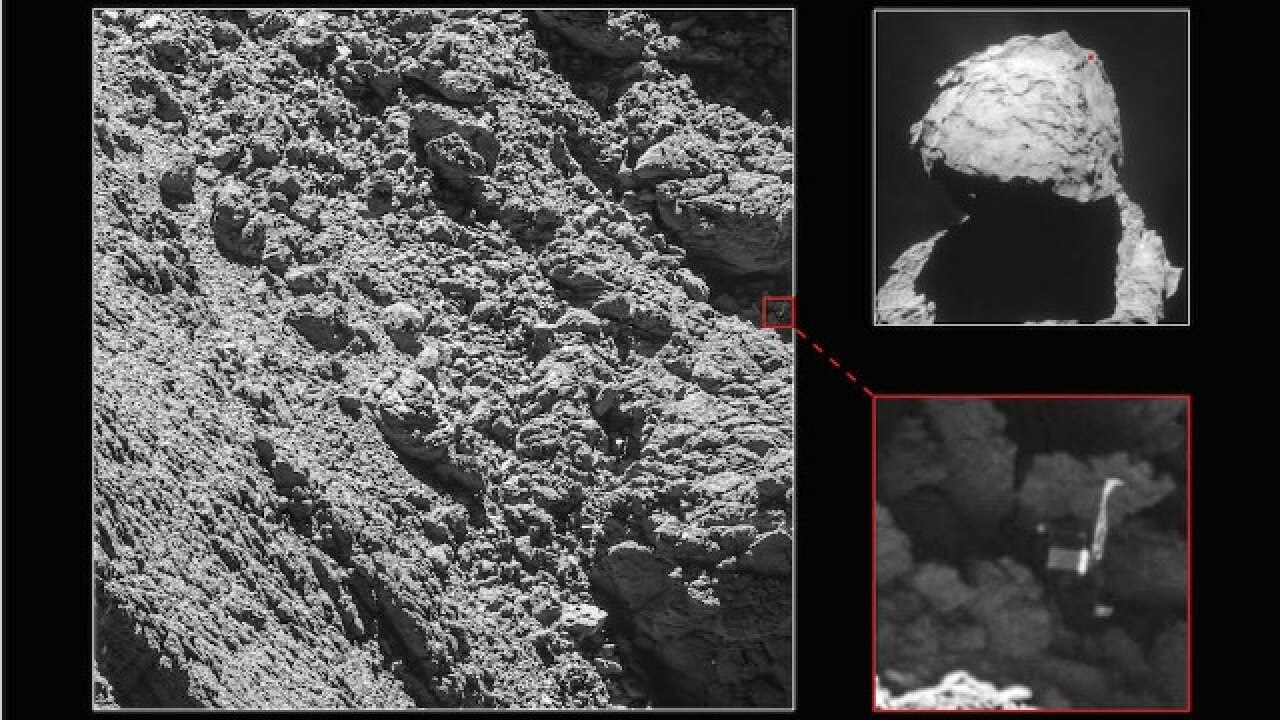Space probe spots missing comet lander philae
- Select a language for the TTS:
- UK English Female
- UK English Male
- US English Female
- US English Male
- Australian Female
- Australian Male
- Language selected: (auto detect) - EN

Play all audios:

European Space Agency' Rosetta spacecraft has captured images of the Philae comet lander after nearly two years of no communication. European Space Agency's Rosetta spacecraft
finally spotted the tiny comet lander Philae stuck in a dark crack on the surface of its comet home. This is the first glimpse of the robot lab since it crash landed nearly two years ago,
ground controllers said today. The European Space Agency (ESA) released a photograph of the washing machine-sized robot lab on the comet's rough surface, one leg thrust into the air.
> THE SEARCH IS OVER! I’ve found @Philae2014!! > https://t.co/a39zKc4Tz3 #CometLanding #PhilaeFound > pic.twitter.com/Dubx5MpGSZ > — ESA Rosetta Mission (@ESA_Rosetta) September
5, 2016 The image, captured with the Rosetta orbiter's OSIRIS narrow-angle camera on Friday last week, were downloaded two days later -- just weeks before the official end of the
ground-breaking science mission to unravel the mysteries of life on Earth. "With only a month left of the Rosetta mission, we are so happy to have finally imaged Philae and to see it in
such amazing detail," Cecilia Tubiana of the OSIRIS camera team, the first person to see the images, said in a statement. The 1.3-billion-euro (USD 1.4-billion) mission, saw Rosetta
launched into space in March 2004, with Philae riding piggyback. The pair travelled some 6.5 billion kilometres (four billion miles) to enter comet 67P/Churyumov-Gerasimenko's orbit in
August 2014. Three months later, Rosetta sent the 100-kilogramme probe down to the comet surface, starting a deep-space saga closely followed around the world via cartoon recreations of the
pioneering pair. Philae landed on the comet in November 2014 in what was considered a remarkable feat of precision space travel but the metre-sized robot bounced several times after its
harpoons failed to fire into the comet surface, and ended up in a ditch shadowed from the Sun's battery-replenishing rays. Until now, nobody knew exactly where. "This remarkable
discovery comes at the end of a long, painstaking search," said Rosetta mission manager Patrick Martin. "We were beginning to think that Philae would remain lost forever. It is
incredible that we have captured this at the final hour." > So happy to have seen @Philae2014 again before my mission ends later > this month...more about my #CometLanding soon!
> pic.twitter.com/ErB0ROrgP6 > — ESA Rosetta Mission (@ESA_Rosetta) September 5, 2016 Philae's nail-biting exploits earned it a loyal Twitter following. It managed to send home
data from 60 hours of experiments, before its batteries failed and it entered standby mode. The robot woke up in June 2015, and sent eight messages to Earth before falling permanently silent
in July 2015. Scientists expect to get a final glimpse of Philae later this month, when Rosetta snaps some pictures during close fly-bys, before crash-landing on the comet itself on Sept.
30, ending its 12-year space odyssey. _(With Agency Inputs)_